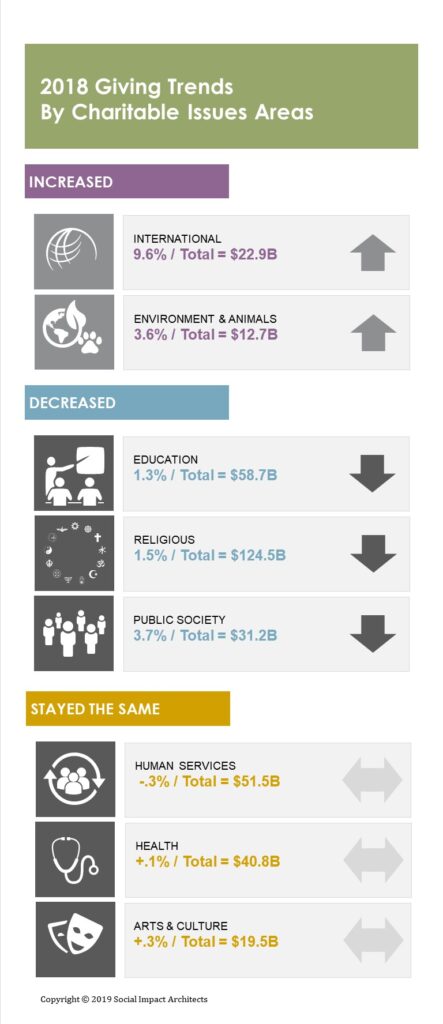 Last week, Giving USA shared its long-awaited report, Giving USA 2019: The Annual Report on Philanthropy for the Year of 2018. In this post, we not only share a synopsis of giving trends from the report, but as always, we provide actionable steps you can take to keep your organization’s fundraising on track.
Last week, Giving USA shared its long-awaited report, Giving USA 2019: The Annual Report on Philanthropy for the Year of 2018. In this post, we not only share a synopsis of giving trends from the report, but as always, we provide actionable steps you can take to keep your organization’s fundraising on track.
First, the good news – Americans gave an estimated $427.71 to U.S. charities in 2018, which was almost a 1% increase. The bad news – adjusted for inflation, total giving declined 1.7% following a record-breaking giving year in 2017. Many economists believe 2018 would be shaky due to two shifts – 1) the Tax Cuts and Jobs Act, which led to reduced giving (see our related blog post) and 2) the volatility of the stock market.
Some issue areas fared better than others – the chart below summarizes the winners and losers in 2018. Many of the losers had gains in 2017, and it is not unusual to see a dip in giving in the following year.

We also saw record-breaking giving by foundations, with an increase of 7.3% – totaling almost 18% of all giving. Corporations also gave more in 2018 – likely due to corporate tax cuts, a robust economy and growth in many sectors.
One of the most disturbing trends noted in the report as well as other research from 2018 is that the social sector’s donor mix is shifting. Individual giving declined by 1.1% in 2018. The number of total households giving is declining, which means that the overall giving by major donors is increasing while donors who give smaller amounts is decreasing. This is likely connected to the reduction of individuals itemizing their taxes in 2018 – which dropped from 45 million households to 20 million households. Research is also showing that donor acquisition is suffering as well as retention of current donors.
Solutions for Working Smarter in 2019-2020
Most economists are predicting that the U.S. will fall into a recession in the next two years. So, it is even more important to get your development departments working smarter and not harder to raise money and support for your cause. Here are some tips we have seen work:
- Solution #1: Monitor donors regularly
Whether through a database or another tool, know and monitor donor trends over time. Based on giving trends, pay special attention to the middle-income segment for changes. Offer bundling options, so households can donate every other year. Practice hyper-stewardship to keep them connected to your cause. - Solution #2: Retention, Retention, Retention
The easiest donor to get is the one you already have. Develop a donor ladder that starts with your first engagement with donors at a gala or event and helps them become regular donors through experiences with your nonprofit (e.g., volunteering). Then, once they are regular donors, start working with them to increase their gifts. Gather board members and your advisory council members together for a “calling/note-writing party” to thank donors, ask for increased gifts and encourage lapsed donors to re-engage. - Solution #3: Elevate messaging through storytelling based on best practices
Double-check your story. Is it resonating as it once did? We have always believed that nonprofits should lead with messages around their unique value proposition and find ways to stand out from the crowd. We recommend focusing more on the value you bring to the community and your clients than the value of tax deductions to donors. You may also want to go deeper and try messaging to each donor segment. Based on donor research we have done with clients, different messages work at different life stages as well as at different motivation and engagement levels. Check out our new e-learning course on Storytelling for fresh ideas to revamp your messages. - Solution #4: Rethink your program portfolio
In making decisions about programs and grants, you need two approaches: 1) a proactive approach that allows you to intentionally raise money to support innovative programs and needs, and 2) a more reactive approach that allows you to be opportunistic and strategically pursue interests that are aligned with your mission. Taken together, this creates a grant decision-making system that helps you move away from feeling like you are chasing money and move toward building a purposeful process that ensures that your important programs flourish. Use tools like the Mission-Money Matrix to assess programs against fundraising potential to determine your “sweet spot” for your program portfolio. The Matrix brings clarity to this discussion and creates a proactive strategy to build a grant pipeline that supports your organization’s most important work and, ultimately, a more sustainable way of doing business. - Solution #5: Rethink your fundraising schedule
Because there were fewer taxpayers itemizing, end-of-year annual appeals will be less compelling, except to those inspired to give during the holiday season. This gives nonprofits an ability to communicate with donors on a regular basis throughout the year, which we encourage. It also means that these appeals need to find new and better ways to create a sense of urgency and importance in the mind of the donor.
For a deeper dive in to the Giving USA data, Nonprofit Quarterly has an excellent webinar – visit their site for the recording and slides. We welcome any additional analysis on giving trends as well as any ways your organization is “working smarter” in its fundraising efforts.
